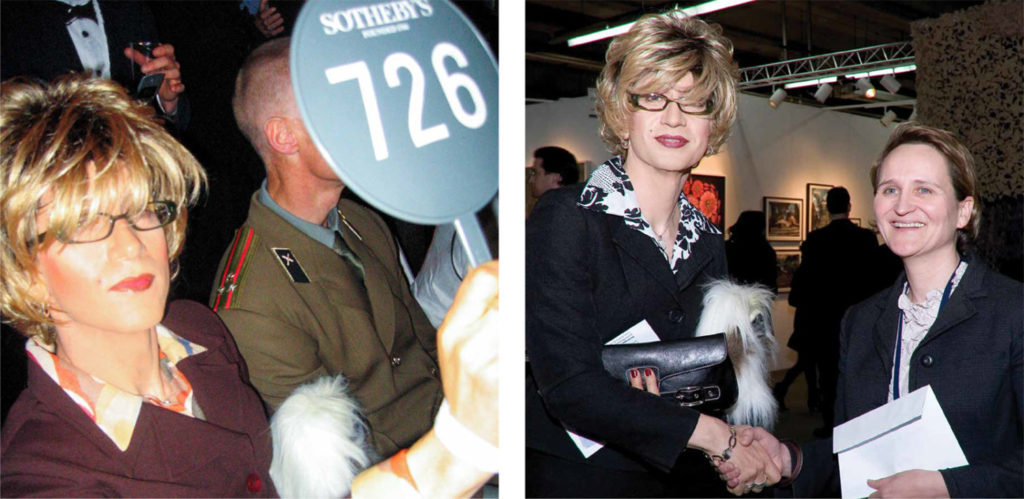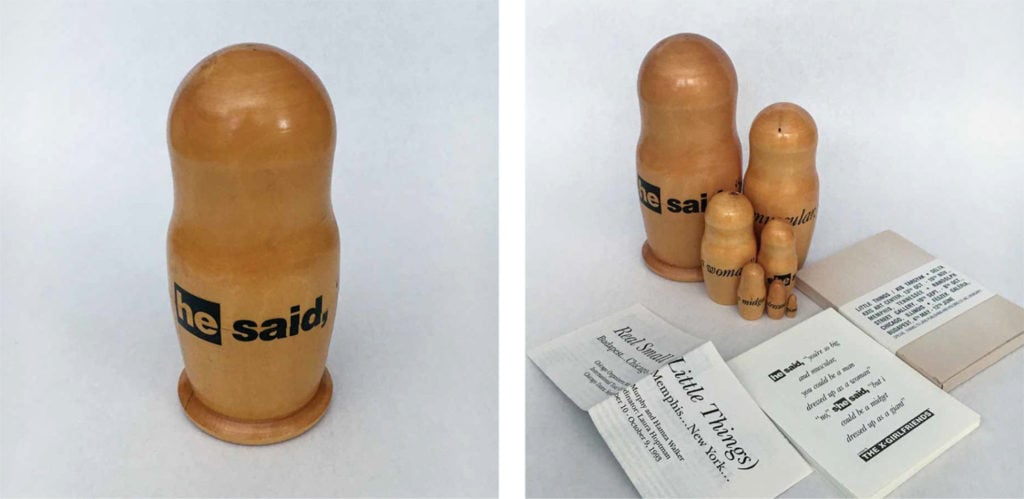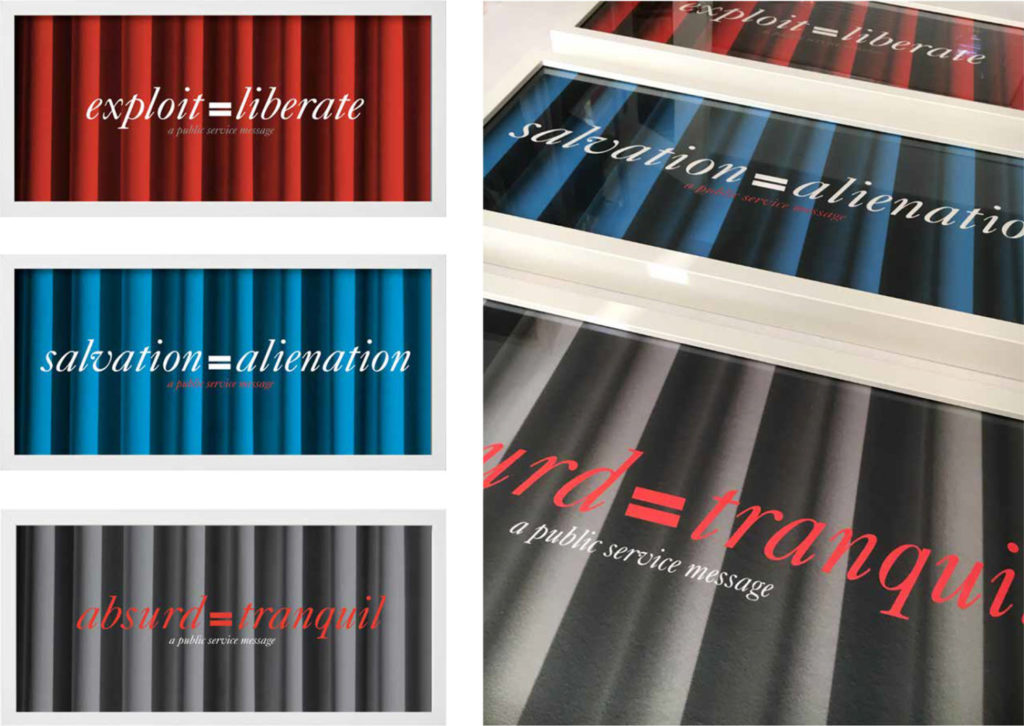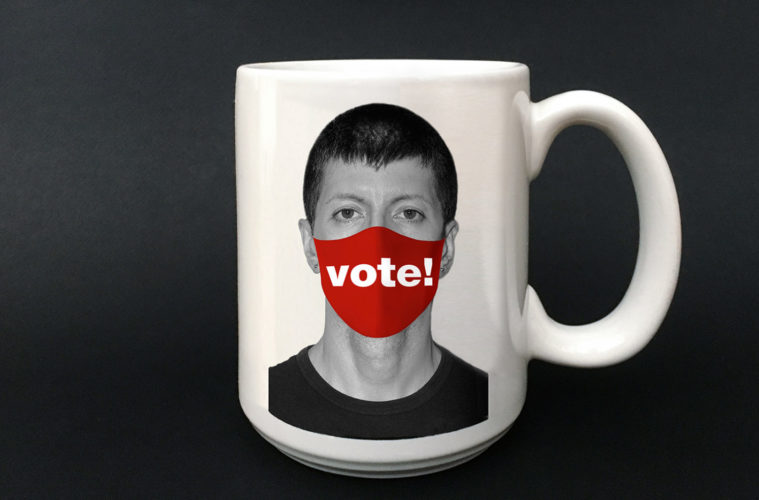Kulov operates at the intersection of performance, propaganda and activism. Across a practice with elements of graphic and commercial design, fashion culture, character studies, publishing, and philanthropy, Kulov takes aim at the alleged progressivism of so-called high society, in both politics and the institutional art world. With provocative commentaries and unapologetically queer and trans-positive narratives, Kulov contrasts their lived experience in a socialist country with the continuum of freedom and oppression in American culture. Their new project — The Equality Series — drops on Election Day this year, with a photo-based edition containing traces of past works whose refreshed critical relevancy is actually rather alarming.
L.A. WEEKLY: When did you first know you were an artist?
KULOV: Hmmm… I think one always knows. But I try not to think of it much, since we tend to attribute a certain exceptionalism to that word, with which I still feel a bit uncomfortable, despite having been an artist for quite a long time now.
What is your short answer to people who ask what your work is about?
In short, I tell people that I’m an interdisciplinary artist who focuses on political public art and performative actions. However, those two interdisciplinary cores of my work don’t necessarily overlap. The first one takes on the form of political or social messages and visual commentaries, which through the use of various media in the public sphere are intended to provoke thought and create dialogue. My performances, on the other hand, are mostly interactive and focus primarily on queer issues, especially when it comes to agency, access, and financial power.

Kulov as their performance-art character Malgorzata Romanska at the annual fundraising auction of Los Angeles Contemporary Exhibitions (LACE) in 2006 (left, photo by L. Molina); and as a corporate sponsor of Pulse New York, awarding the 2008 prize for the best emerging artist at the fair to the representing gallerist (Photo by L. Ligon)
What would you be doing if you weren’t an artist?
Oh, that’s easy — I would definitely be a female soul singer. When I was young, I saw a performance by Jennifer Holliday (who was the original Effie in Dreamgirls). I believe that it was on one of those Arista anniversary television specials from Radio City Music Hall, or something like that. She sang that famous hit from the musical and she literally brought the house down. I was in awe (and still am), and ever since then I’ve always dreamt of having this kind of powerful emotional effect on people through artistic expression. But unfortunately, I’m way more than six degrees of separation from being a Jennifer Holliday. So I’ve resorted over the years to keep my day job in the hopes for the chance of another lifetime to manifest such unattainable dreams.
Did you go to art school? Why/Why not?
I actually went to a regular university with a fairly good art department. And my favorite classes were my core ones, which I was required to take as part of a liberal arts education, such as philosophy, writing, and of course art history. In fact, I’ve been going further into that latter direction for the past few years and away from visual or performative expression. Perhaps one day, it will all come full circle.
Why do you live and work in L.A., and not elsewhere?
I relocated to L.A. after being based in Amsterdam for several years. At the time, I didn’t want to live in a gray and super urban North American center again (I had also lived in Chicago), so my choices were between San Francisco and Los Angeles. I chose the latter, since I was seeking a more drastic visual change to my urban surroundings from what I had experienced in Amsterdam. Plus as an extra benefit, L.A. had a large arts community. Now that I’ve been here for a long time, I feel kind of stuck but in a good way — I have a great set-up, plus the weather is usually fantastic.

Kulov, Gender S(e)izing (He:She), 10 x 3 x 3 inches, color transfers on wood, with catalog, 1993–94
When was your first show?
As part of my art practice I tend to avoid making art objects for sale or for exhibitions, unless it’s for a charity cause. Or I try to alter and decontextualize my public art projects in such a way as to amplify the fact that they don’t really belong in an enclosed gallery space. But early in my career, Hamza Walker (who’s currently the director of LAXART) was co-curating what may also be one of his first exhibitions. It was called Real Small (Little Things), and he asked me to participate in it. So I utilized one of my visual commentaries on gender issues and created a piece for it called Gender S(e)izing (a.k.a. He/She). It was shown at Randolph Street Gallery in Chicago, and also at Art In General in New York and Delta Axis in Memphis. And I believe in Hungary as well.
When is/was your current/most recent/next show?
I’m actually releasing my first proper photo edition on Election Day called The Equality Series. It takes one of my political visual commentary statements Exploit = Liberate from the early 1990s and builds upon it by adding a couple of more such statements, with the hint “a public service message” appearing under each one of them. For the past few years, as we find ourselves in a very similar (and even more dire) political climate as when I first started my art career, I’ve been either re-presenting work from that period or using it as a springboard from which to create “new” work. This is another such project, and 20% of all sale proceeds will be donated to the American Civil Liberties Union (ACLU). They are an awesome organization and I feel that no matter what happens in this election, they will continue to be super busy and to need our support.

Kulov, The Equality Series, 10 x 20.5 x 1.25 inches each, giclee photo prints on fine art paper, framed, 2020
What artist living or dead would you most like to show with?
For the political public art aspect of my work, probably Barbara Kruger or Jenny Holzer. And perhaps Lynn Hershman Leeson or Eleanor Antin for the performative one. Or maybe Korean artist Nikki S. Lee for both.
Do you listen to music while you work? If so what?
Yes, always! Although I also listen to NPR a lot, I switch to music often, especially when I hear Trump’s voice on the radio too many times. Musically, I’m kind of stuck in the late 1990’s and early 2000’s with electronic lounge and that type of vibe. In fact, I go through long obsessive periods of listening only to my CDs from that time, as I usually don’t have digital versions of them on my phone.
Website and social media handles, please!
Advertising disclosure: We may receive compensation for some of the links in our stories. Thank you for supporting LA Weekly and our advertisers.

